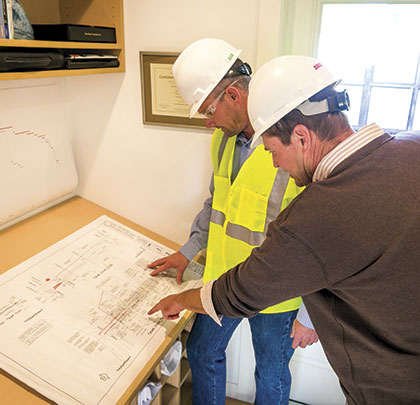Even with today’s advanced scheduling technology, construction projects are still plagued with continuous, yet avoidable delays. Odds are, we’ve all been involved with a project that’s been delayed unnecessarily. These delays end up costing the project—and those involved—time and money. Inevitably, we ask ourselves, “What can we do better?” The answer is simple. With proper planning and coordination among the project’s subcontractors and vendors during preconstruction, delays can be mitigated or even eliminated.
ASK THE RIGHT QUESTIONS
The following eight questions, with roots in the Lean Construction process known as “Pull Planning,” go a long way toward building a schedule that eliminates surprises that can lead to those nasty delays we all want to avoid.
- When is it necessary to have all the proper paperwork cut? The first step in commencing a construction project, cutting contracts or purchase orders, is many times the least appreciated when it comes to its importance to scheduling. Many delays can be attributed to not releasing subcontractors or vendors with properly executed paperwork in a timely fashion. Without this critical first step in place, material, equipment, and manpower won’t be scheduled when necessary.
- Are long lead items accounted for? When creating a construction schedule, the focus is naturally towards the physical on-site construction activities. If the required materials aren’t available when needed, however, delays are automatic. Once the paperwork is cut to the subcontractors and vendors, the follow-up needs to focus around those items with the longest lead times. These items may include submittals and shop drawings that require approvals, fabrication, and delivery. All of these steps need to be accounted for in order to build an accurate construction schedule.
- What conditions are required on the jobsite? All jobsites have their own unique conditions that sometimes require advanced planning prior to starting work. Special requirements may include power/electrical, water, type of equipment, material applicability, staging/access, hoisting, and weather and temperature of the site. If a subcontractor or vendor shows up on-site unprepared for the job, delays can occur while they scramble to make the necessary jobsite preparations.
- What conditions are required by corresponding trades? In addition to site-specific requirements, some trades may expect the project to be left in a certain condition that’s not expected from prior trades. Also known as the “hand-off,” many project schedules have been derailed by two corresponding trades that don’t collaborate on their requirements. The discussion of trade expectations needs to happen early on to avoid miscommunication and scheduling faux pas.
- What is the task duration? This may seem like an obvious question, but you would be surprised at how many superintendents and project managers don’t ask their subcontractors or vendors what they believe the proper task duration is. Don’t leave this up to guessing or “prior experience” when creating the construction schedule. Always ask the trade responsible for performing a task what they believe the proper task duration is. This not only provides for the most realistic task durations, but also sets up the expectation with that subcontractor that they’re expected to complete their task within their stated duration.
- What manpower is required? A task duration is almost always based on an assumed crew size. Many schedule delays could have been avoided if the proper manpower requirements were provided upfront. Knowing the requirements allows subcontractors to have enough manpower for the project and not impact the schedule. In addition to manpower, there may be other requirements the task duration is dependent upon, including equipment and material availability. Knowing all the variables that a task duration is dependent upon provides for an important schedule management tool.
- What work can happen concurrently? Not every activity is important or warrants critical attention. That doesn’t mean you can forget about the non-critical items. If not scheduled properly, these activities can become critical. Coordinating non-critical work with the appropriate trades during preconstruction can help to ensure these tasks don’t become problematic. Knowing where and when to do concurrent work without negatively affecting the critical path can keep a project running smoothly and on-time.
- If a project is phased, where will work start and end and how will it be sequenced? Phased projects have their own unique set of requirements. Sometimes each phase of phased work needs to be treated as its own separate construction project. You may need to ask the above seven questions for each individual phase. Regardless, location of work start and stop points becomes critical to the project’s participants’ understanding of the flow of work and sequencing during phased projects. You’ll want to avoid not having a subcontractor working in the proper location or having too many subs in the same location at the same time.
THE LONG AND SHORT OF IT
Most contractors are able to create critical path schedules that look pretty and sophisticated on paper. Without the proper input and coordination during preconstruction from the actual trades doing the work, however, these schedules are rarely reliable as tools to keep a project on track. Gaining buy-in early on with subcontractors and vendors allows for the creation of a more accurate and informed schedule. This schedule can then become the management tool used to avoid delays and save all of the project participants’ time and money.
Asking these eight simple questions can lead to the successful and timely completion of your next project. ■
Photo courtesy of Santaella Media.
About the Author: Joshua Schneider is president of Blue Water Construction Inc., a turn-key construction management and consulting firm specializing in commercial, high-end residential, and agricultural projects. Schneider is a LEED Accredited Professional and has extensive training in Lean Construction philosophies. Contact Joshua at jschneider@bluewaterconst.com.
_________________________________________________________________________
Modern Contractor Solutions – January 2016
Did you enjoy this article?
Subscribe to the FREE Digital Edition of Modern Contractor Solutions magazine.



